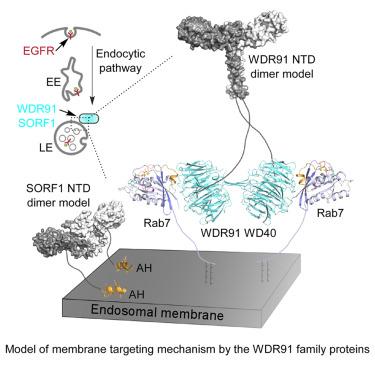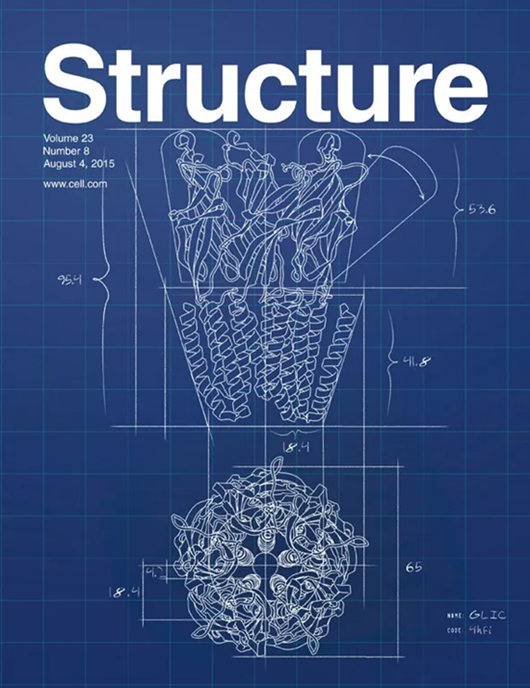Insights into the distinct membrane targeting mechanisms of WDR91 family proteins
IF 4.4
2区 生物学
Q2 BIOCHEMISTRY & MOLECULAR BIOLOGY
引用次数: 0
Abstract
WDR91 and SORF1, members of the WD repeat-containing protein 91 family, control phosphoinositide conversion by inhibiting phosphatidylinositol 3-kinase activity on endosomes, which promotes endosome maturation. Here, we report the crystal structure of the human WDR91 WD40 domain complexed with Rab7 that has an unusual interface at the C-terminus of the Rab7 switch II region. WDR91 is highly selective for Rab7 among the tested GTPases. A LIS1 homology (LisH) motif within the WDR91 N-terminal domain (NTD) mediates self-association and may contribute partly to the augmented interaction between full-length WDR91 and Rab7. Both the Rab7 binding site and the LisH motif are indispensable for WDR91 function in endocytic trafficking. For the WDR91 orthologue SORF1 lacking the C-terminal WD40 domain, a C-terminal amphipathic helix (AH) mediates strong interactions with liposomes containing acidic lipids. During evolution the human WDR91 ancestor gene might have acquired a WD40 domain to replace the AH for endosomal membrane targeting.

深入了解 WDR91 家族蛋白的不同膜靶向机制
WDR91 和 SORF1 是含 WD 重复蛋白 91 家族的成员,它们通过抑制内体上磷脂酰肌醇 3- 激酶的活性来控制磷脂酰肌醇的转化,从而促进内体的成熟。在这里,我们报告了人类 WDR91 WD40 结构域与 Rab7 复合物的晶体结构,该结构域在 Rab7 开关 II 区域的 C 端有一个不寻常的界面。在测试的 GTPases 中,WDR91 对 Rab7 具有高度选择性。WDR91 N-末端结构域(NTD)中的一个 LIS1 同源(LisH)基团介导了自结合,并可能部分导致了全长 WDR91 与 Rab7 之间的相互作用增强。Rab7结合位点和LisH基序对于WDR91在内吞转中的功能都是不可或缺的。对于缺乏 C 端 WD40 结构域的 WDR91 同源物 SORF1 而言,C 端两性螺旋(AH)介导了与含有酸性脂质的脂质体的强烈相互作用。在进化过程中,人类 WDR91 祖先基因可能获得了一个 WD40 结构域,以取代 AH 进行内体膜靶向。
本文章由计算机程序翻译,如有差异,请以英文原文为准。
求助全文
约1分钟内获得全文
求助全文
来源期刊

Structure
生物-生化与分子生物学
CiteScore
8.90
自引率
1.80%
发文量
155
审稿时长
3-8 weeks
期刊介绍:
Structure aims to publish papers of exceptional interest in the field of structural biology. The journal strives to be essential reading for structural biologists, as well as biologists and biochemists that are interested in macromolecular structure and function. Structure strongly encourages the submission of manuscripts that present structural and molecular insights into biological function and mechanism. Other reports that address fundamental questions in structural biology, such as structure-based examinations of protein evolution, folding, and/or design, will also be considered. We will consider the application of any method, experimental or computational, at high or low resolution, to conduct structural investigations, as long as the method is appropriate for the biological, functional, and mechanistic question(s) being addressed. Likewise, reports describing single-molecule analysis of biological mechanisms are welcome.
In general, the editors encourage submission of experimental structural studies that are enriched by an analysis of structure-activity relationships and will not consider studies that solely report structural information unless the structure or analysis is of exceptional and broad interest. Studies reporting only homology models, de novo models, or molecular dynamics simulations are also discouraged unless the models are informed by or validated by novel experimental data; rationalization of a large body of existing experimental evidence and making testable predictions based on a model or simulation is often not considered sufficient.
 求助内容:
求助内容: 应助结果提醒方式:
应助结果提醒方式:


